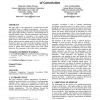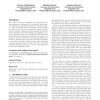59 search results - page 5 / 12 » A Computer Simulation Laboratory for Social Theories |
KDD
2012
ACM
11 years 9 months ago
2012
ACM
The communities of a social network are sets of vertices with more connections inside the set than outside. We theoretically demonstrate that two commonly observed properties of s...
HICSS
2005
IEEE
14 years 1 months ago
2005
IEEE
Studies have shown that deception in the hiring process is common. Since more people are using computer mediated communication for job interviewing, it is important to understand ...
UPP
2004
Springer
14 years 22 days ago
2004
Springer
Self-assembly is the spontaneous self-ordering of substructures into superstructures driven by the selective affinity of the substructures. DNA provides a molecular scale material...
GECCO
2005
Springer
14 years 28 days ago
2005
Springer
This paper offers a novel approach to coevolution based on the sociological theory of symbolic interactionism. It provides a multi-agent computational model along with experimenta...
SIGECOM
2009
ACM
14 years 1 months ago
2009
ACM
We consider models for bargaining in social networks, in which players are represented by vertices and edges represent bilateral opportunities for deals between pairs of players. ...



